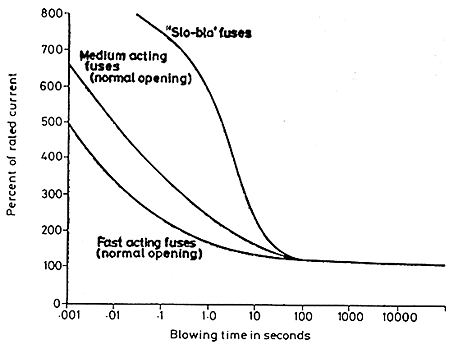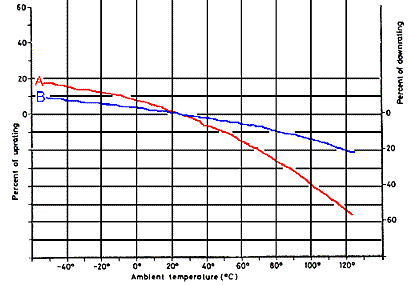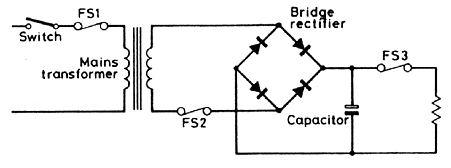|
| ||
| | Plug Fuses (UK)Before we confuse you completely with the mathematics, let's look at some typical UK "230 volt 13 Amp plug" fuse ratings for appliances. The purpose of a UK plug fuse is to melt before the cable does, thus reducing the risk of fire. This gives extra protection in line with the house fuse box or circuit breaker. It also makes it less likely that you'll receive an electric shock, in the case of a fault. If you use the highest possible rating (13 Amp) the appliance will work but you may have less cable protection.
All appliances should be marked with the correct plug fuse rating so look for this first. It is usually on a "rating plate" or label on the appliance or on a label on the plug cord. Please note that the label on the plug itself tells you which fuse is supplied with the plug and NOT which fuse ought to be fitted! Appliances with a motor and/or heating element, such as a washing machine, dishwasher, vacuum cleaner, will usually require a fuse with the maximum rating of 13 Amps. Appliances with a small heating element (toaster, clothes iron, electric kettle) will also need a high rating fuse of 7 or 13 Amps. Lamps, radios, small TV sets etc. with a rating up to 100 Watts (or 100 VA) need a fuse of 3 Amp rating. | |
| |
Equipment Fuses
In modern electronics, fuses play a very important role which is frequently misunderstood, with the result that expensive equipment is often not protected fully, and this can result in expensive repair bills. The history of fuses is as old as the use of electricity and probably goes back to the time of the first short circuit! At first, fuses were simple open-wire affairs but around 1890 Edison enclosed the wire into a lamp base to make the first enclosed fuse. By 1904 the Underwriters Laboratories had introduced specifications covering fuse size and ratings to meet the safety standards of the period. In 1927 Littelfuse started making the first of their range of low amperage fuses for the budding electronics industry. Since that time many new types of fuses have appeared on the market, some with very special characteristics for particular types of protection, and today the choice is extremely large. In this article it is proposed to take a look at the more common types encountered by the home constructor and to show how by selecting the correct type for any particular circuit, better protection can be provided and the risk of expensive repair bills reduced. You can Buy fuses here. | |
| Send this page address - CLICK HERE - to a friend ! | ||
|
Purpose of a FuseA fuse is a device which is introduced into an electrical circuit to prevent excessive current flowing under fault conditions. On overload the wire forming the fuse element will heat up and melt (or blow) and interrupt the current flow, preventing damage from excessive current to the remaining circuits. It is the electrical equivalent of a "safety valve". The characteristic of most importance to the home constructor is the current rating and, regretfully, this rating is often misunderstood. The current rating of a fuse is established by the manufacturer after a series of tests under controlled conditions. This enables the manufacturer to publish a set of specifications for his product which design engineers can use to decide which is the correct type of fuse for a particular circuit. In order to understand the current rating of a given fuse it is important to know the conditions under which this rating was achieved. There are three main groups of fuses, viz. slow-blow (or anti-surge), normal quick acting, and very fast acting. There is also a fourth type known as time delay fuses. Each of these types will protect a circuit from excessive continuous current, but act very differently under surge or short time conditions. The fitting of the wrong type could mean no protection at all is being provided, or fuses that keep "blowing" for no apparent reason.
Fig. 1.1: Chart showing the relation of percent of rated current to blowing time Let us now take a detailed look at each type. The blowing time in seconds plotted against percentage overload for the three main types of fuse mentioned above is shown in Fig. 1.1. It can be seen that up to 100 per cent overload there is very little difference between the three types. But if we take a current overload of say 500 per cent we can see that the fast acting fuse blows in 0.001 seconds (a millisecond) and the slow-blow in about 2 seconds with the normal acting fuse at about 0.01 seconds. Quite a considerable difference between the three types. In fact the ratios (taking our normal acting fuse as the reference) work out at one tenth of the time for our fast acting fuse and 200 times longer for our slow-blow type! A very big difference indeed and more than enough to decide the fate of expensive semiconductors under fault conditions.
Fig. 1.2: Chart showing effect of ambient temperature on current carrying capacity If we now look at Fig. 1.2, we can see how the temperature also has an effect on the current rating. As the ambient temperature becomes lower the amount of current required to "blow" a fuse becomes higher and this can make a considerable difference to the blowing times under surge conditions. In fact taking our slow-blow and normal fuses we can see that the two curves actually cross over at low temperatures. This could require a change of ratings for low and high temperature operation. Although this curve applies to the continuous current rating the overload performance may also be affected. When deciding on a suitable fuse under extreme temperature conditions it is important to carry out a series of tests with simulated faults to check the actual results in practice. However this is unlikely to affect the home constructor as most domestic equipment is operated at or around 20°C with possible lower temperatures of 0°C (cold room on a frosty morning), so the "normal" manufacturers rating can be used for all practical conditions, but it is as well to know that the current rating may be different at extremes of temperature. Ah, you may be thinking, let's use a fast acting fuse all the time and be safe. Regretfully this is not practical as many circuits have a high surge current when first switching on, or switching to change operating conditions.
Fig. 1.3: A typical power supply circuit A typical power supply circuit consisting of a mains transformer with a bridge rectifier and smoothing capacitor is shown in Fig. 1.3. A load resistor is also shown to provide a steady working current. Fuses are shown in three different places (although in practice only one fuse may be fitted) to show how the type of fuse required depends on its position in the circuit. Assuming a 240 volt a.c. input and say an output of 12 volts at 8 amps d.c. we can consider what types of fuse are required. When the switch is made (or closed) there will be a very high surge current into the primary of the transformer and if the making of the switch just "happened" to be at the time that the sinewave input was at its peak, we could be applying _/2 x 240 volts across a few Ohms (the d.c. resistance of the primary). A typical 100VA mains transformer would have a d.c. resistance of say 20 Ohms. This could result in an initial surge current of 17 amps. We know that our output from the power supply is 12 volts at 8 amps, i.e. 96 watts, assuming losses bring this up to 100 watts our continuous current at the primary would be 0.416 amps. So for continuous use we require a fuse which will handle, say, 0•5 amps, but it must also handle a switch-on surge of up to 17 amps for about 2.5 milliseconds (the peak of a 50Hz cycle).
Fig. 1.1: Chart showing the relation of percent of rated current to blowing time Looking at Fig. 1.1 we can see that a slow-blow type of fuse will handle surges of up to 800 per cent for around 0.01 seconds (10 milliseconds). So taking our maximum peak surge current as our worst case we need a fuse that will handle a surge of 17 amps for at least 2.5 milliseconds. So 17 divided by 8 equals. 2.1 amps and a fuse rating of 2.5 amps continuous should prove satisfactory. In the event of a fault condition this fuse rating would blow after around 1 minute with an overload current of 5 amps or so. It is important that this level of current is reached under fault conditions and tests should be made to establish this fact. Normally a fuse in the primary of a transformer will protect the transformer and bridge rectifier from, say, a short-circuit smoothing capacitor. However, there may be conditions where a fuse in this position will not provide protection. For example, suppose our mains transformer has windings with a high d.c. resistance. If the primary winding had a resistance of 75 Ohms, then a short across the secondary circuit could only increase the primary current to a maximum of 340 divided by 75, or 4.5 amps, and in certain circumstances this may not "blow" the fuse before the transformer burns out. Mind you, in the example shown such a transformer would also result in very poor regulation at the output. A paradox, but it is more difficult to correctly fuse a poorly designed circuit than a well designed one simply because the current under fault conditions isn't high enough! Coming now to our second fuse (FS2) position (in series with the bridge rectifier), although we still have a surge of current, at switch-on the actual conditions are different from our first example. Before switching on the smoothing capacitor is in a discharged state and therefore acts like a short circuit across the output of the bridge rectifier. When we switch on a large current will flow into the capacitor and start to charge it up and as it does so the level of current will fall as the voltage across the capacitor rises. We are concerned here with three levels of current, the normal load current, the initial surge current, and the likely fault current. We know that our output is 12 volts d.c. and this is the result of the capacitor charging up to the peaks of the rectified input from the bridge. As upon switching on the capacitor is discharged we are only concerned with the maximum voltage from the transformer via the bridge applied to a discharged capacitor (effectively a short circuit). The r.m.s. output from the transformer is around 8.5 volts plus, say, 1 volt to allow for the voltage drop across the rectifier at full load, a total of 9.5 volts. No circuit is perfect and there will be a small resistance in the connecting leads and in the internal connections of the capacitor, as well as the resistance of the transformer secondary (we will ignore the primary resistance for our example). Let us assume that the secondary winding has a resistance of 0.2 Ohms and that all the other resistance in the circuit equals 0.1 Ohm. This makes a total of 0.3 Ohms
Fig. 1.3: A typical power supply circuit in series with the current flow into the capacitor at the time of switching on, so our _/2 x 9.5 volts is looking into 0.3 Ohms for the first fraction of a second and this will produce a surge current of 44.8 amps! Our fuse must be able to handle this surge without "blowing". Our normal maximum load current we know is 8 amps and we also know that a slow-blow fuse will handle an 800 per cent overload for 0.01 seconds (10 milliseconds) and this would seem to be suitable for use here if we use a fuse rated at 10 amps because this will handle a surge of 80 amps. But, we now have to contend with the time constant of the capacitor circuit and this will depend on the value of capacitor used and also the amount of resistance in the circuit. A rough rule of thumb is to use a l000µF for every amp of load current so the most likely value of capacitor in practice would be 10000µF. We know that the resistance is equal to 0.3 Ohms and the time taken for the current to drop to 33 per cent of its initial value is C x R. Therefore our time constant is 0.01 farad x 0.3 Ohms, or 0003 seconds (3 milliseconds). Our slow-blow fuse will handle up to around 80 amps for 10 milliseconds, so in this example would be suitable to use. If a larger value of capacitor was in use or the circuit resistance was lower (or both) then the same fuse may no longer be suitable. For example, if the resistance was as low as 0.1 Ohm our surge current would peak at 134 amps which would blow the fuse. Likewise a capacitor of 50 000µF and a resistance of 0.3 Ohms would give a time constant of 15 milliseconds and again the fuse could blow. Of course all this is very over-simplified as all the factors mentioned will interact with each other and make actual calculation almost impossible, but the example serves to show the general picture of what is happening and why a slow-blow type of fuse is required. Coming now to our third position FS3 (in the output), we may have an unknown factor present and that is, do we know the type of load likely to be presented to the circuit? If it is a capacitive load then we have to apply the same method of deciding on a fuse as a surge may occur. However, if it is a resistive load we only have to consider the load current and a fuse with a rating just above the current flowing, and a normal or fast-acting fuse could be used. A fuse in this positon will only protect the power supply in the event of external faults; it will not give any protection for internal faults. A well-designed power supply would be fitted with fuses in all three positions. By now the reader should be aware that fusing is not the simple thing that so many people think it is; a fuse is a complicated device and must be chosen with consideration of all the factors in a particular situation. Let us now consider the construction of a typical cartridge fuse. First it has to have a body or barrel and this is normally made of glass or ceramic material. The barrel will have some form of termination at each end, usually brass or copper, which has been plated to prevent corrosion. The fuse element will be connected between the two end terminations and enclosed within the barrel. It will consist of a single wire in the case of a quick acting fuse, or may be one or more wires arranged in a specific way for delay and anti-surge types. Sometimes a filler is used to modify the action of the fuse and this may be sand or quartz powder. This filler will absorb the energy of the arc when the current is interrupted. Fuses are of course marked in some way as to type and ratings, normally on one or both of the end caps and in addition there may be an indication of one of the many standards that the particular fuse complies with, e.g. BS, SEMKO, etc. The size of fuse may vary but there is a number of standard sizes and the most common are the Continental Standard which is 20mm long by 5mm diameter and the British plug top standard of 1 inch by 1/4 inch diameter. The other common size used in British equipment is the 1.25 inch by 1/4 inch diameter. Many other sizes are available ranging from 5mm long to over 200mm and of course there is a number of other styles available for special purposes. Fuse CharacteristicsThere are two main characteristics which will concern the home constructor and these are maximum continuous current rating and the surge rating of slow-blow types. The rupturing capacity of a fuse may also be important and for completeness is mentioned here. A high rupturing capacity (h.r.c.) fuse is capable of interrupting currents in the order of thousands of amperes. It would have a ceramic body and also contain an arc-quenching medium. Non-h.r.c. fuses (more common in home constructed equipment) do not have an arc-quenching medium and are only suitable for surge currents up to about 50 amps. With higher currents than this they would be very likely to explode when they blow. Fusing SpeedA quick-acting fuse is designed to react both to short and long term overload conditions. They are very robust in construction and will withstand shocks and vibration. But they do tend to have a higher resistance and the voltage drop caused by this may be a problem in some applications. This higher resistance also means that more heat is produced and this must be effectively dissipated. Time delay fuses will react to long term overload currents but will withstand transient surges without harm; several types are available. For example, one type has what looks like a spring inside the barrel and these will stand up to surges of around ten times the normal rating for 75 milliseconds. Another type has a "blob" in the middle of the fuse element and this type has a reduced surge capacity, typically ten times rated current but only for 25 milliseconds. Time delay types have a very low resistance and can be used in enclosed places as there is little self-generated heat but they are only available in the lower current ratings. Both the "spring" and the "blob" type are time delay fuses. So far we have mentioned only the current rating of fuses, but they also have a maximum voltage rating. This voltage rating has no effect on the current rating but is important nevertheless. When a fuse "blows" an arc is developed between the two ends of the broken fuse element and, if the voltage across these ends is high enough, the arc will be maintained and the current will not be interrupted. This condition could result in considerable damage to the equipment. Arcs are readily produced in high voltage circuits or where inductive loads are being used and, in these conditions, the voltage rating of a fuse must not be exceeded. Fuses can be used at their current rating at all voltage levels up to their maximum. When it is known for certain that, although the circuit has a high voltage present, the power available is limited, it is possible to use a fuse at a higher voltage than that for which it is rated. This is common practice in domestic electronic equipment and quite safe. But. if in doubt, keep within the voltage ratings given by the manufacturers. | ||
| Send this page address - CLICK HERE - to a friend ! | ||





